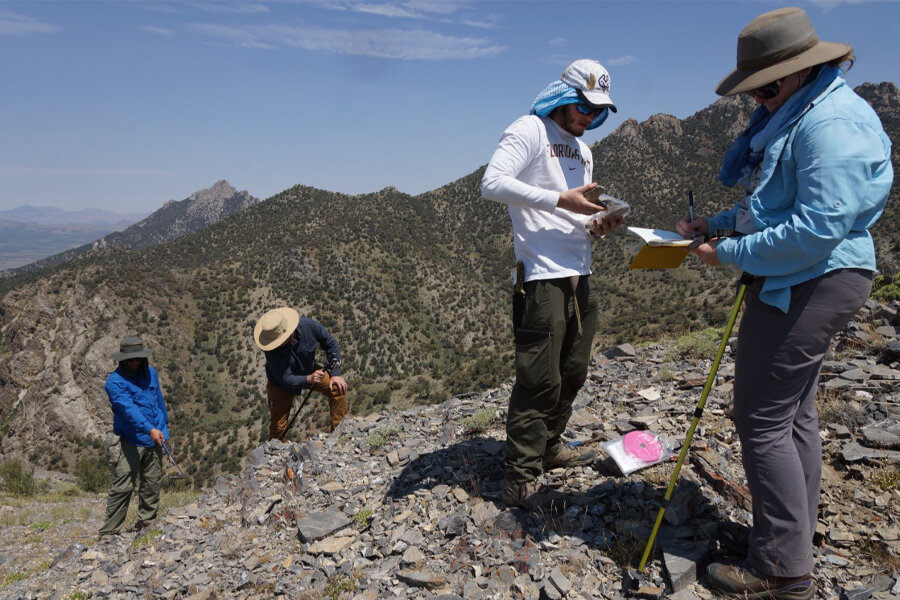Seth Young’s research group collecting and describing limestone samples from a field site in the Roberts Mountains, Nevada. Credit: Anders Lindskog/Florida State University
Florida State University researchers have new insight into the complicated puzzle of environmental conditions that characterized the Late Ordovician Mass Extinction (LOME), which killed about 85% of the species in the ocean.
Their work on the 445-million-year-old mass extinction event was published online in the journal AGU Advances on Monday.
“We found that reducing conditions—with low to no oxygen and little to no hydrogen sulfide levels—are probably playing a much more important role than we previously thought,” said lead author Nevin Kozik, a doctoral candidate in the Department of Earth, Ocean and Atmospheric Science and researcher at the FSU-headquartered National High Magnetic Field Laboratory. “If you imagine a pie chart of the causes of this extinction, we’re increasing that wedge that signifies oxygen deficiency, which is happening in concert with a cooling climate and widespread habitat loss due to sea-level change.”
The research is the first study to use measurements of multiple elements from several sites to examine the conditions that led to the LOME, the second-largest extinction event in the Earth’s history and the only mass extinction to occur during what are called icehouse conditions, when Earth’s climate is cold enough at the poles to support ice sheets year-round.
To measure oxygen and sulfide concentrations from millions of years ago, scientists use geochemical proxies that correspond to ancient marine conditions. Iodine concentrations and sulfur isotopes from three sites provided information on the oxygen and sulfide levels in the ancient ocean.
The extinction happened in two distinct pulses. Using these geochemical measurements as environmental proxies, the researchers found that oxygen levels decreased ahead of the first pulse and remained low. Levels of hydrogen sulfide in the oceans decreased initially leading into the first pulse of the extinction event, but then these levels increased afterward coinciding with the second and final pulse of the extinction.
At the same time the Earth’s climate was cooling, glaciers were growing at the ancient South Pole (modern-day North Africa), which led to decreasing sea levels and habitat loss for marine organisms in shallow seaways in the tropics.
“The geological record indicates that many environmental factors were at play leading to this extinction event,” Kozik said. “The processes we are linking together here are like several punches that beat down life during this time.”
Even while conditions were becoming inhospitable for many organisms around the planet, the environment in some places remained oxygen-rich and able to support a diversity of life. The researchers found evidence of higher oxygen levels at a site near present-day Quebec that was home to a shallow reef on the continental shelf 445 million years ago.
“We know that life had to survive and persist after this mass extinction, and we now have an indication that at least this location had enough oxygen to support life,” said co-author Seth Young, associate professor in the Department of Earth, Ocean and Atmospheric Science and researcher at the FSU-headquartered National High Magnetic Field Laboratory. “That’s consistent with what you find in the rock and fossil records, which are that reefs are persisting through this extinction event. The fossils are suggesting that, at least there, life was OK.”
The extinction event is an ancient analogue to what’s happening on Earth today. Earth today, as in the Late Ordovician, is in an icehouse period and is experiencing a major loss in biodiversity, a warming climate and a decrease in oceanic oxygen.
“All of those things are really important and provide a modern perspective on this mass extinction event,” Young said. “It’s important to not only understand what caused this extinction event, but also how did the Earth system get out of this and continue on. That’s the impetus for studying many of these things, not only to understand why this happened, but what was the survival period like and what led to the reemergence and rediversification of life.”
Researchers from Virginia Polytechnic Institute and State University and University of California, Riverside contributed to this study.
Researchers find oxygen spike coincided with ancient global extinction More information: Nevin P. Kozik et al, Geochemical Records Reveal Protracted and Differential Marine Redox Change Associated With Late Ordovician Climate and Mass Extinctions, AGU Advances (2022). DOI: 10.1029/2021AV000563 Provided by Florida State University
Citation: Researchers find low oxygen and sulfide in the oceans played greater role in ancient mass exteinction (2022, January 10) retrieved 11 January 2022 from https://phys.org/news/2022-01-oxygen-sulfide-oceans-greater-role.html
This document is subject to copyright. Apart from any fair dealing for the purpose of private study or research, no part may be reproduced without the written permission. The content is provided for information purposes only.
































